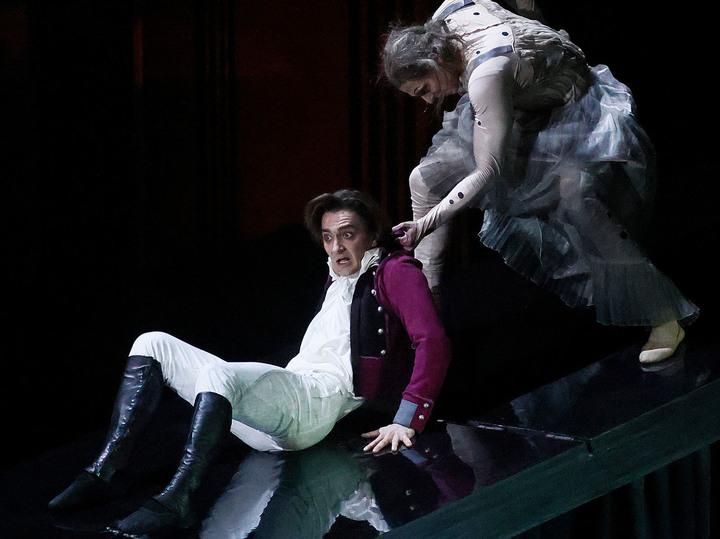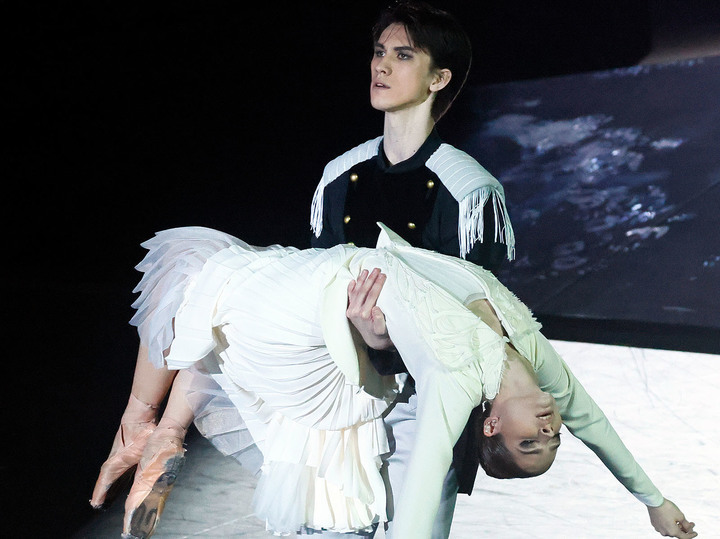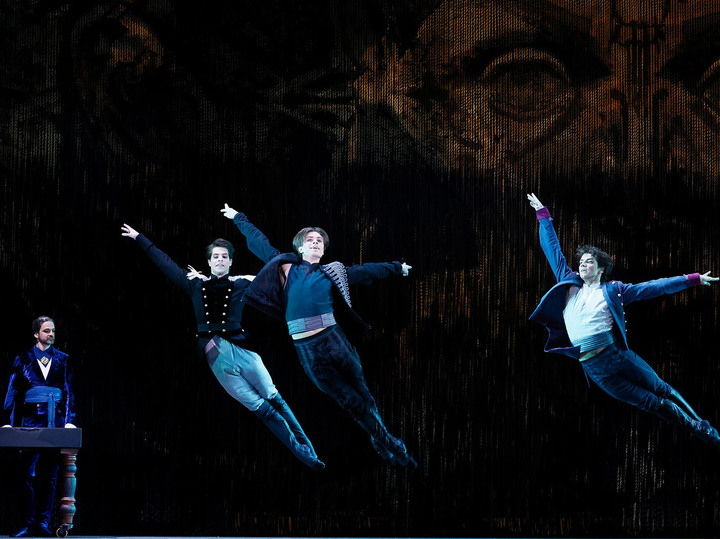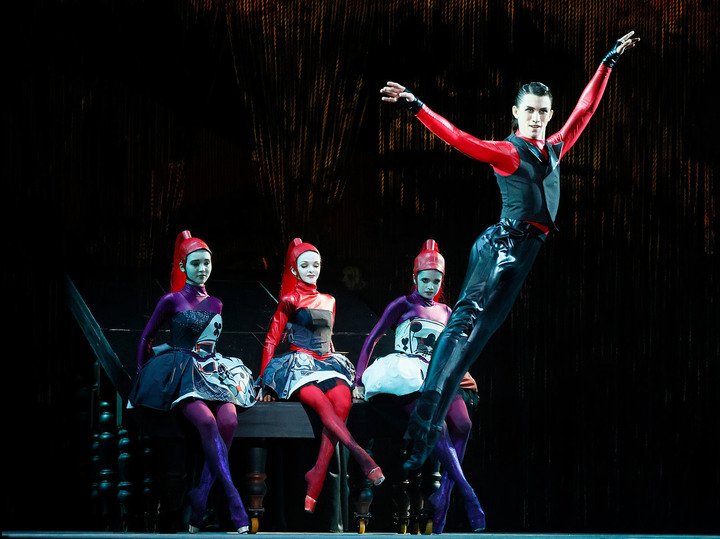Bolshoi bet on the Queen of Spades
[ad_1]
From the MK dossier: The plot of “The Queen of Spades” was suggested to Pushkin by the young Prince Golitsyn, who, having lost, regained what he had lost by betting money, on the advice of his grandmother, on three cards that had once been suggested to her by Saint Germain. This grandmother is a well-known “mustachioed princess” in Moscow society, a maid of honor at the court of four emperors, Natalya Petrovna Golitsyna, née Chernysheva, the mother of the Moscow governor Dmitry Vladimirovich Golitsyn. The story in the manner of Hoffmann and Nodier was a tremendous success. “My “Queen of Spades” is in great fashion. Players punt on three, seven, ace,” Pushkin wrote in April 1834.
As a ballet, the story has been staged on stage several times (Possokhov staged the tenth production) – starting in 1940, when the production to Tchaikovsky’s music was first performed by the famous dancer and choreographer, then director of the Paris Opera Ballet, Serge Lifar. People began to turn to it especially often in the last few years: in 2018, the production was performed for the Royal Danish Ballet by English choreographer Liam Scarlett; the following year, 2019, Iñaki Urlezaga staged a ballet for the Leonid Yakobson Ballet Theater. It is interesting that all the choreographers, without exception, who staged “The Queen of Spades” used Tchaikovsky’s music to bring their concept to life.
A one-act ballet to the music of Tchaikovsky, “The Queen of Spades,” has also already been performed at the Bolshoi with great success. In 2001, it was staged by the great French choreographer Roland Petit. The ballet, 23 years earlier, was originally staged by Mikhail Baryshnikov, and Petit used music from Tchaikovsky’s opera of the same name. During the production of the ballet at the Bolshoi Theater, the choreographer’s concept was transformed, and he turned to the VI Symphony of the great composer.

In contrast to the genius in its brightness and laconicism, with the fantastic Countess, who was embodied on stage by Ilza Liepa (before he found her, Petit, in despair, had already begun to try on the role for himself), Posokhov’s new ballet, in comparison with the ballet by Roland Petit, extended to two acts, detailed and scrupulous to the smallest detail.
The main know-how of the performance: all the events in the ballet are shown as if from inside Herman’s psyche, and the second act is an exposition of the protagonist’s soul, on the other side of his, turned inside out, consciousness. Before us is the landscape of his psyche, showing the audience its most hidden corners.
This is Posokhov’s seventh production (and fifth original) at the Bolshoi Theater. In all of his original performances for the Bolshoi, Posokhov staged ballets together with one of the directors of the drama theater. However, this time he did not use director’s help, limiting himself to working with Moscow playwright Valery Pecheykin.
In almost all scenes, the libretto is primarily based on Pushkin’s story: like Pushkin, the action begins with a card game at the famous gambler Chekalinsky (in Tchaikovsky’s opera, the first scene takes place in the Summer Garden); the main character is not too in love with Lisa and is more interested in the secret of the three cards, and he uses Lisa to a greater extent, having first seen the girl in the window of the countess’s house and followed her to the ball. Possokhov and Pecheikin present Lisa not as the rich heiress of the Countess, which we see in Tchaikovsky’s opera (for this, the Countess has a grandson Tomsky in the ballet), but as her poor relative and pupil. The girl does not throw herself into the Winter Canal, as in the opera – at the last minute she is saved by Yeletsky, whom she successfully marries. And the action ends not with the death of the hero, but in the Obukhov hospital for the mentally ill, in which German is doomed to spend his life.
But the presence of elements from the script of Tchaikovsky’s opera is also strongly felt in the new ballet. Thus, Liza’s fiancé Yeletsky, the hero of Tchaikovsky’s opera, is actively present in the ballet, who is not among Pushkin’s heroes, but there is an indication of Liza’s successful marriage after Herman goes crazy. There are other moves in the ballet by Modest Tchaikovsky, the composer’s brother, who developed the libretto for his opera. So we have before us a peculiar hybrid of Pushkin’s story and Tchaikovsky’s opera.
Nevertheless, as Roland Petit once did, it is the score of Tchaikovsky’s opera that underlies the work of composer Yuri Krasavin, who subjected the classic’s music to serious processing – according to the composer himself, “everything melodic here is given to Pyotr Ilyich, but there is not a single bar.” from the original source, which I would not remake.” This is not entirely true, but Krasavin did not do anything blasphemous with Tchaikovsky’s music, he worked with it carefully and accurately, unless, of course, we consider the very possibility of remaking the music of the great composer to be blasphemy and impudence. But different classical music lovers may have different opinions on this matter.

Among other things, composer Krasavin includes other works by Tchaikovsky in his score. For example, the ballet ends with “Elegy. In Memory of I.V. Samarin.” Krasavin also uses the Third Symphony, to fragments from which, like Balanchine in “Jewels,” Posokhov sets the scene of a ball in St. Petersburg. Or the play “Death of a Doll” from Tchaikovsky’s “Children’s Album”. The funeral of the Countess takes place under it in the ballet, and a cornflower blue coffin appears on stage “dancing” and flying, as if in Gogol’s “Vie.” The corps de ballet dancers not only wear it, performing various dance figures with its help, but also literally “put it on the butt” and from there the Countess, using the elastic stretchy material, like a cobra, claws at Herman’s hand, and then tries to get out of the coffin.
But even more important is that Krasavin’s score is actually an opera-ballet: many popular arias, both female and male, from the orchestra pit are sung here in different compositions by countertenors Vadim Volkov and Vladimir Magomadov. And the countertenor parts in the play are no less important detail of the production than the dancers’ dances.
The title character of the ballet, Countess Anna Fedotovna, who after her death will turn into the mystical Queen of Spades, appears in two persons in Posokhov’s ballet: a seductive young woman and a terrible old woman. At the very beginning of the ballet – when Tomsky, lucky in cards, tells his friends the story of his grandmother and her acquaintance in Versailles with the famous adventurer, alchemist and occultist Count Saint-Germain, whom the “Venus of Moscow”, as she is called in Paris, seduces in order to find out the secret card success – she appears young and beautiful (the best young Countess in a ballet of three casts is Alena Kovaleva). Although the Versailles scenes themselves were scanty in the ballet and turned out to be poorly developed.
But already at the ball in St. Petersburg, the Countess appears as an old woman, and her man plays. Moreover, by the will of the choreographer, this old woman easily, like a monkey, hangs in Herman’s room on the crossbars, like a spider crawling along the wall, unceremoniously gives Herman a kick in the ass, which makes her image somewhat caricatured.
True, she does this in the scenes after her death, and, apparently, the director wanted to present her as a terrible ghost, convey her supernatural strength and show her flying. It turned out badly, and it takes remarkable skill and charisma of the artists to overcome this caricature and present the real mystical Queen of Spades to the public. The troupe’s premier, Denis Savin, succeeded more than other performers as the Countess.
But the choreographer turned out the scenes with the dancing cards perfectly. His vocabulary, as always, is brilliantly musical, but hellishly complex and overly danceable – a huge number of movements and connections per unit of time. But this does not cause fuss on stage, as it did in the choreographer’s early works. On the contrary, it creates a feeling of lightness, swiftness and inevitability of the impending outcome. And the role of Ace has generally become one of the most winning for ballet dancers, and it looks especially brilliant when performed by Mark Chino.

In addition to the split image of the Countess (remember that in the ballet “Hero of Our Time” Possokhov used three Pechorins), among other ideas of the director, there are seven ugly doubles of the main character, with whitewashed faces and disheveled hair, which are designed to reflect the different essences of Herman’s internal state. This technique is also not new, and was successfully used for the same purpose and in the same number of entities in John Neumeier’s ballet “Peer Gynt”. But still, such a move cannot be denied effectiveness, and besides, it works well for the concept of the performance.
In developing significant concepts, the choreographer’s co-author in this performance was production designer Polina Bakhtina. This is the second gray curtain dividing the stage space into paintings (there are 8 of them in Act I, and 15 in Act II); and the gray vaults of the scenery, designed as portals to the world of the subconscious; and a mirror in which the old countess sees her young image, and Herman opens fire on him, and thereby releases the twin demons nesting inside her into freedom.
But especially successful in this regard is the transparent cube invented by the artist, luminous along the edges, in the inner space of which the characters of the play find themselves every now and then. Now this is a dating space, and here, for example, Saint-Germain’s love date with a young countess takes place, and banknotes fly around them with the help of a wind blower; then this is Herman’s room, where after death the Queen of Spades appears to him; then, in general, this is some kind of metaphysical space in which, like homunculi in an alchemist’s flask, Herman’s restless soul “toils” and rushes about with its doubles, and they, like fish in an aquarium, are watched by a vengeful old woman who kidnaps Herman right from the card table, and moving his soul into a transparent and scary cube-flask.
Unlike Roland Petit’s not-so-popular one-act ballet, in the new production Yuri Possokhov created a large number of interesting roles for the artists involved in the performance. The choreographer skillfully conducted the casting: all three casts turned out to be different, but equally convincing in their roles.
More consonant with the echo of Tchaikovsky’s opera is Herman, who was shown on stage by Alexey Putintsev. His hero, contrary to the general concept of the play, is still in love with Lisa, and the scene of their dates and final separation is carried out at an extreme emotional level. But Igor Tsvirko’s Herman is closer to the Byronic rebel and romantic hero of Pushkin’s story. The role of Lisa is the most thought-out and organic in Eleanor Sevenard’s role. Count Saint-Germain is irresistible in the performance of Mark Orlov, who of the three casts is the most convincing in the role of Yeletsky (although Mark Chino also performed excellently in the same part in the second cast).

And in the case of Tomsky, whom Possokhov, in terms of his importance for the performance, practically equaled the role of Herman, one’s eyes simply run wild: along with the magnificent Bolshoi premiere Artem Ovcharenko, who by right of seniority should be given the palm, Possokhov risked bringing amazingly talented debutants to the stage – Daniil Potaptsev, who worked at the theater for just a season, was promoted up the career ladder two weeks ago and became a soloist; and yesterday’s graduate of the Moscow Academy Makar Mikhalkin. Both did not disappoint. Despite the fact that both debutants are completely different, and of course, they still have to gain experience in such large and complex roles (this applies to a greater extent to Makar Mikhalkin), both are excellent as dancers, and convincing in their roles as artists.
[ad_2]
Source link






